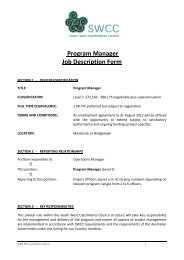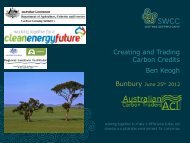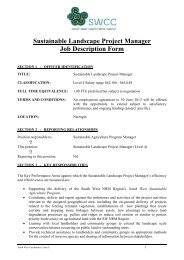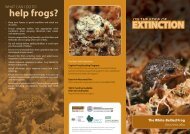Tender for the Programme - South West Catchments Council
Tender for the Programme - South West Catchments Council
Tender for the Programme - South West Catchments Council
Create successful ePaper yourself
Turn your PDF publications into a flip-book with our unique Google optimized e-Paper software.
DRAFT<br />
<strong>South</strong> <strong>West</strong> Regional NRM Strategy – Ancillary Document<br />
Hill, AL, CA S, V S and A Del Marco 1996b Wetlands of <strong>the</strong> Swan Coastal Plain. Vol 2b: Wetland<br />
mapping, classification and evaluation – wetland atlas. Water & Rivers Commission, Perth, WA. 194<br />
pp.<br />
The accompanying atlas to report vol.2a – shows locations of ALL wetlands from Perth to Dunsborough, so very useful resource<br />
to managers.<br />
Jury, C, G Hanran-Smith and D Rooks 2008 Cowaramup Creeks action plan. Technical report prepared<br />
<strong>for</strong> <strong>the</strong> Cape to Cape <strong>Catchments</strong> Group, Margaret River, WA. 85 pp.<br />
This action plan provides in<strong>for</strong>mation about <strong>the</strong> current health of <strong>the</strong> Cowaramup Catchment and recommendations on how to<br />
manage it better. Issues of concern identified during <strong>the</strong> <strong>for</strong>eshore surveys and community consultation were:<br />
Loss of native fringing vegetation and degradation of remaining vegetation by stock grazing and trampling.<br />
The effect of altered hydrology including declining rainfall, on-stream dams and bores on <strong>the</strong> timing and quantity of flow and<br />
<strong>the</strong> ecology of <strong>the</strong> creeks.<br />
Environmental and agricultural weeds threatening good vegetation.<br />
The planting of invasive non-local plants including deciduous trees which threaten <strong>the</strong> character of <strong>the</strong> area and have <strong>the</strong><br />
potential to impact on creek ecology.<br />
Concerns regarding water quality and <strong>the</strong> impact on marine life in Cowaramup Bay.<br />
The potential impact on remnant vegetation from <strong>the</strong> spread of dieback particularly on <strong>the</strong> unnamed creek.<br />
On-going erosion in areas where all creekline vegetation has been removed and grazing is occurring.<br />
The fragmentation of habitats through <strong>the</strong> loss of creekline vegetation connectivity.<br />
In response to <strong>the</strong>se issues, recommendations have been made in this report to protect and improve <strong>the</strong> condition of <strong>the</strong> creeks.<br />
Kavanagh, R, B Law, F Lemckert, M Stanton, M Chidel, T Brassil, A Towerton and T Penman 2010<br />
Conservation value of eucalypt plantations established <strong>for</strong> wood production and multiple<br />
environmental benefits in agricultural landscapes. Final report <strong>for</strong> NAP/NHT2 eucalypt plantations<br />
project SLA 0013 R3 NAP, Forest & Rangeland Ecosystems Research, NSW Industry and<br />
Investment, NSW. 112 pp.<br />
Report documenting capacity of young eucalypt plantations to restore habitat <strong>for</strong> fauna within highly fragmented and ecologically<br />
degraded agricultural landscapes re birds, reptiles, bats and terrestrial mammals.<br />
Kings<strong>for</strong>d, RT, JEM Watson, CJ Lundquist, O Venter, L Hughes, EL Johnston, J A<strong>the</strong>rton, M Gawel, DA<br />
Keith, BG Mackey, C Morley, HP Possingham, B Raynor, HF Recher and KA Wilson 2009 Major<br />
Conservation Policy Issues <strong>for</strong> Biodiversity in Oceania. Conservation Biology, 23: 834–840<br />
MAIN RECOMMENDATIONS ARE SO RELEVANT THAT THEY HAVE BEEN GIVEN HERE IN FULL<br />
Habitat loss and degradation<br />
Implement legislation, education, and community outreach to stop or reduce land clearing, mining, and unsustainable logging<br />
through education, incentives, and compensation <strong>for</strong> landowners that will encourage private conservation<br />
Establish new protected areas <strong>for</strong> habitats that are absent or poorly represented<br />
In threatened ecosystems (e.g., wetlands), establish large-scale restoration projects with local communities that incorporate<br />
conservation and connectivity<br />
Establish transparent and evidence-based state of environment reporting on biodiversity and manage threats within and<br />
outside protected areas.<br />
Protect free-flowing river systems (largely unregulated by dams, levees, and diversions) within <strong>the</strong> framework of <strong>the</strong> entire<br />
river basin and increase environmental flows on regulated rivers<br />
Invasive species<br />
Avoid deliberate introduction of exotic species, unless suitable analyses of benefits outweigh risk-weighted costs<br />
Implement control of invasive species by assessing effectiveness of control programs and determining invasion potential<br />
Establish regulations and en<strong>for</strong>cement <strong>for</strong> exchange or treatment of ocean ballast and regularly implement antifouling<br />
procedures<br />
Climate change<br />
Reduce global greenhouse gas emissions<br />
Identify, assess, and protect important climate refugia<br />
Ameliorate <strong>the</strong> impacts of climate change through strategic management of o<strong>the</strong>r threatening processes<br />
Develop strategic plans <strong>for</strong> priority translocations and implement when needed<br />
Overexploitation<br />
Implement restrictions on harvest of overexploited species to maintain sustainability<br />
Implement an ecosystem-based approach <strong>for</strong> fisheries, based on scientific data, that includes zoning <strong>the</strong> ocean; banning<br />
destructive fishing; adopting precautionary fishing principles that include size limits, quotas, and regulation with sufficient<br />
resources based on scientific assessments of stocks and; reducing bycatch through regulation and education<br />
Implement international mechanisms to increase sustainability of fisheries by supporting international treaties <strong>for</strong> fisheries<br />
protection in <strong>the</strong> high seas; avoiding perverse subsidies and improve labelling of sustainable fisheries; and licensing exports<br />
of aquarium fish<br />
Control unsustainable illegal logging and wildlife harvesting through local incentives and cessation of international trade<br />
Pollution<br />
13






